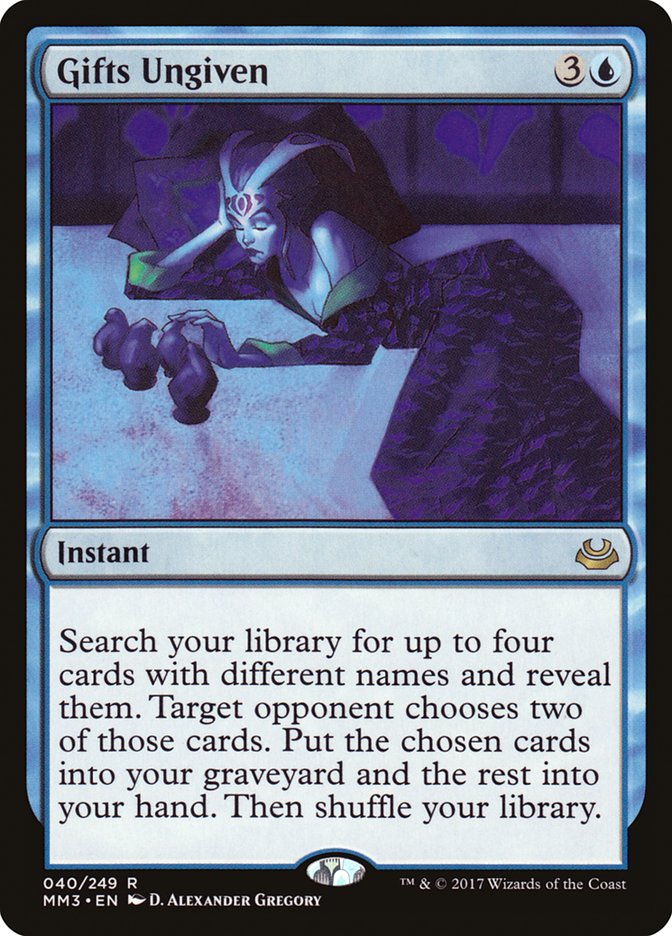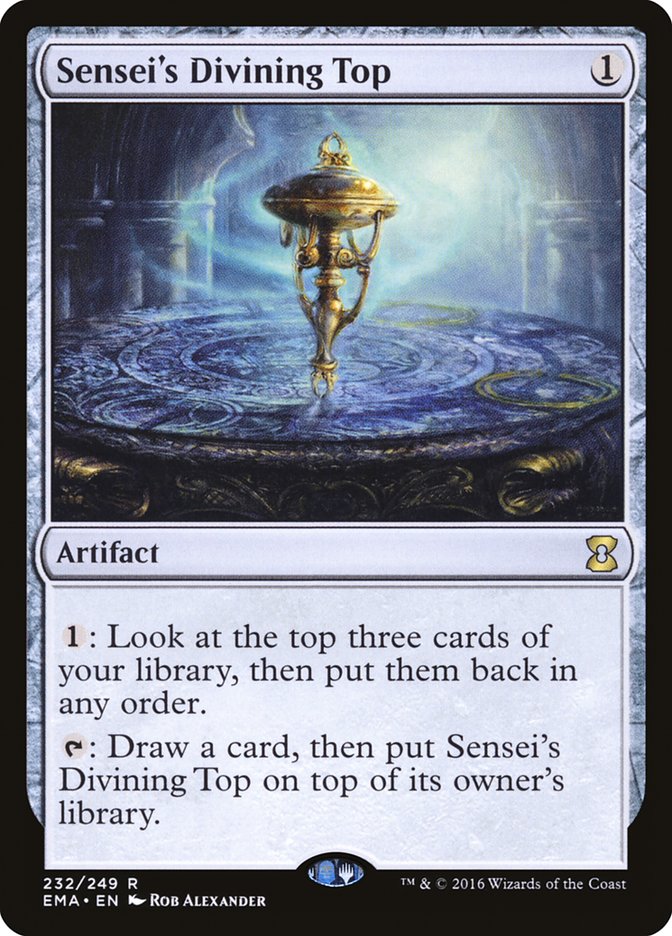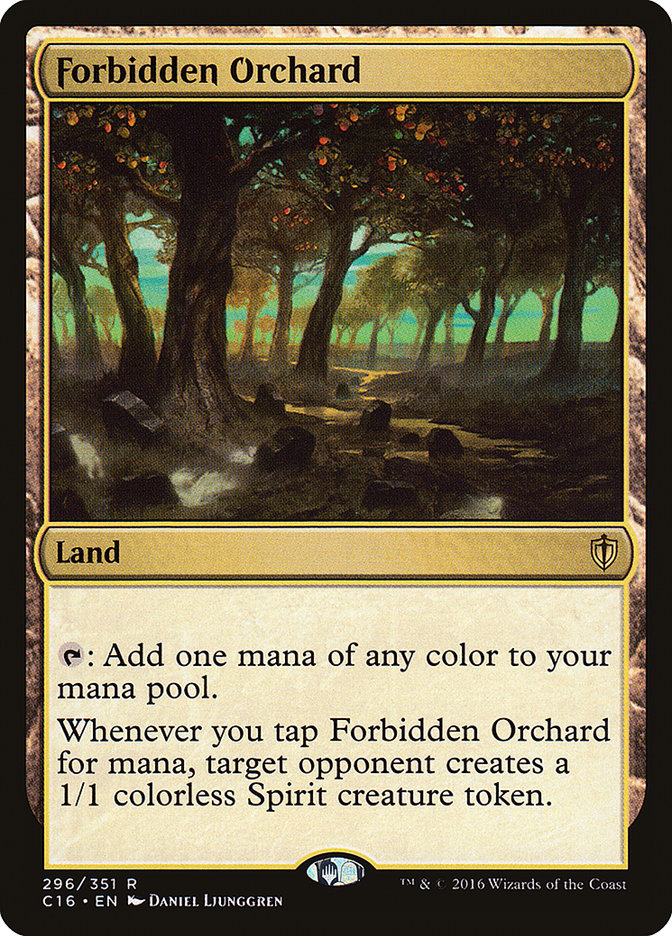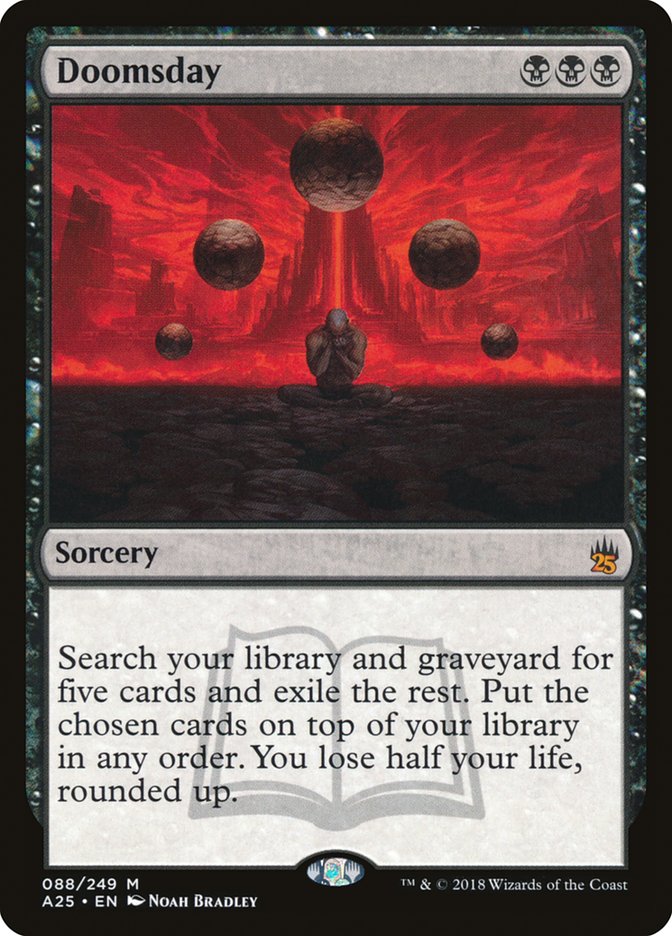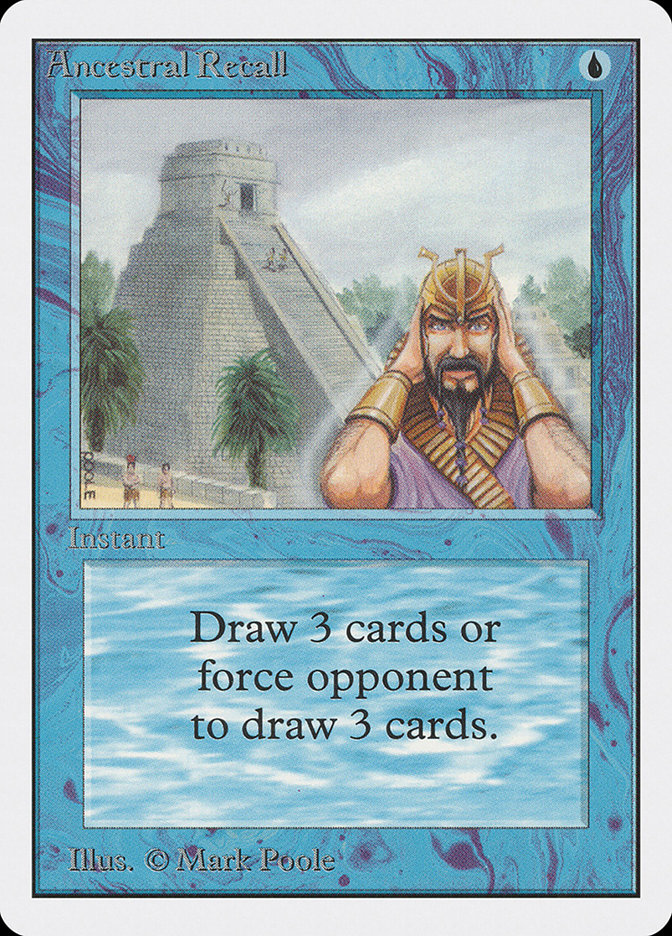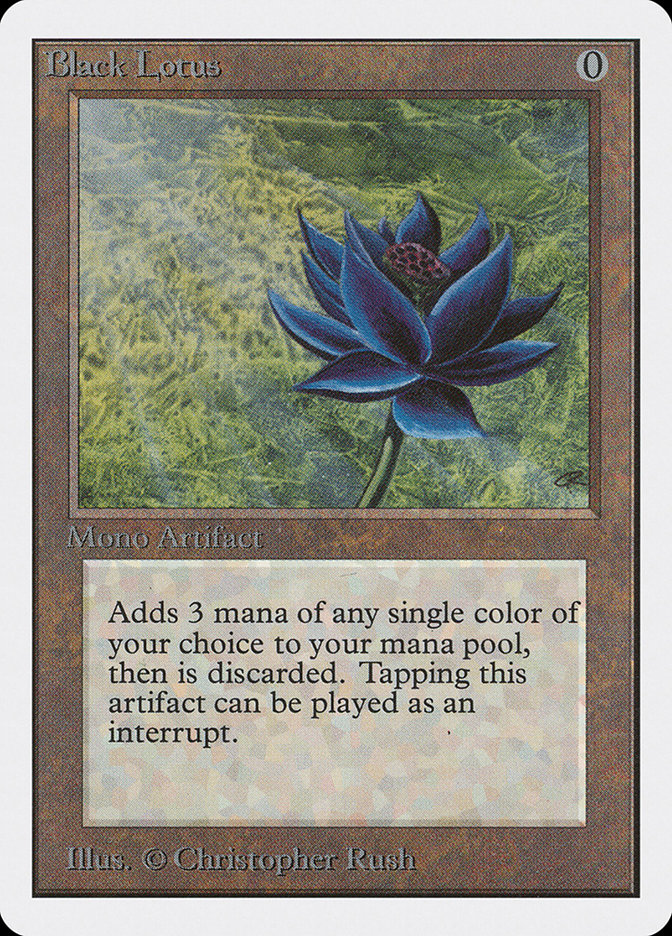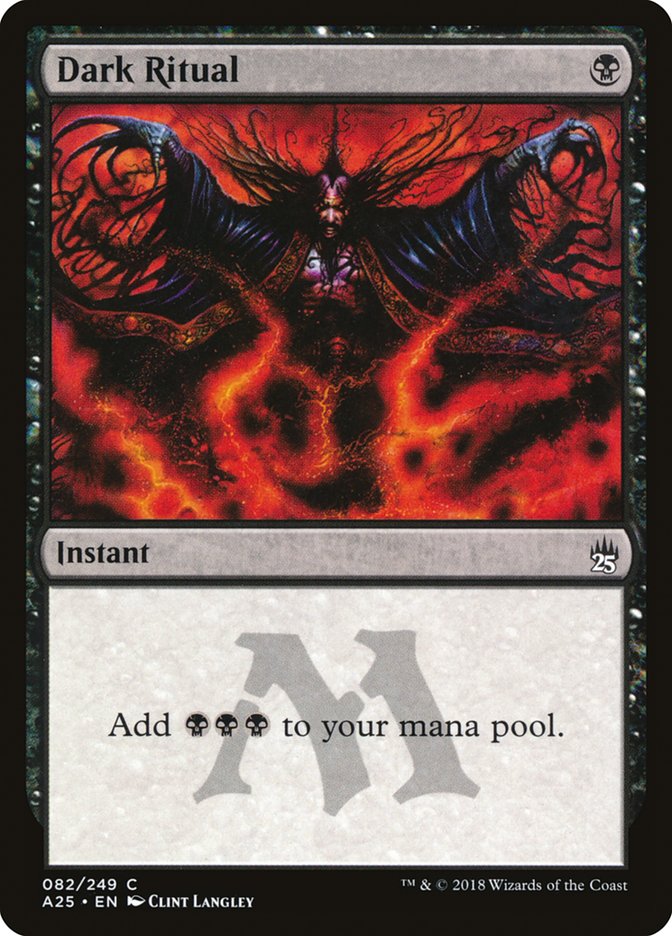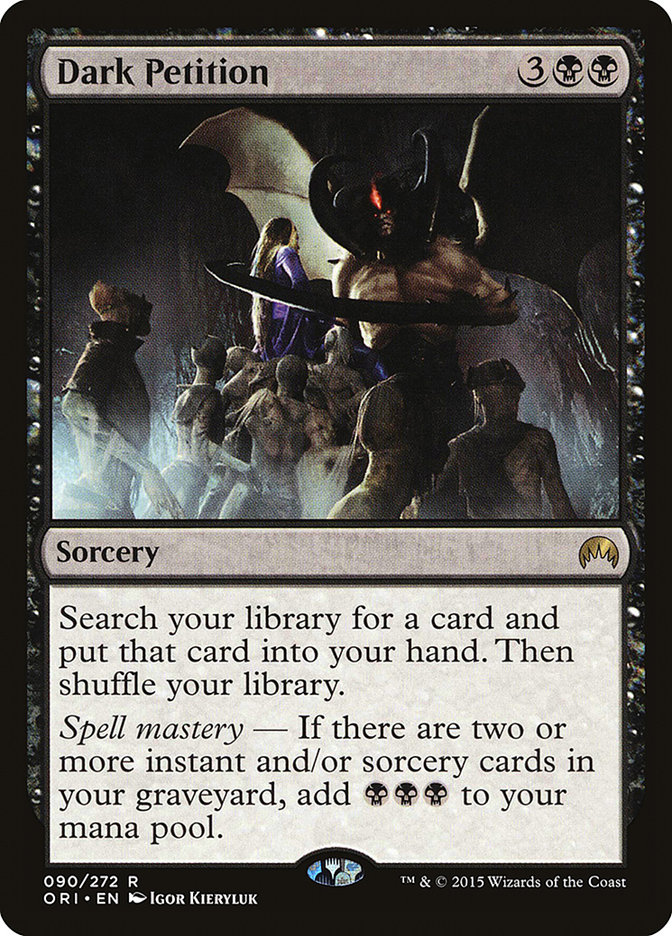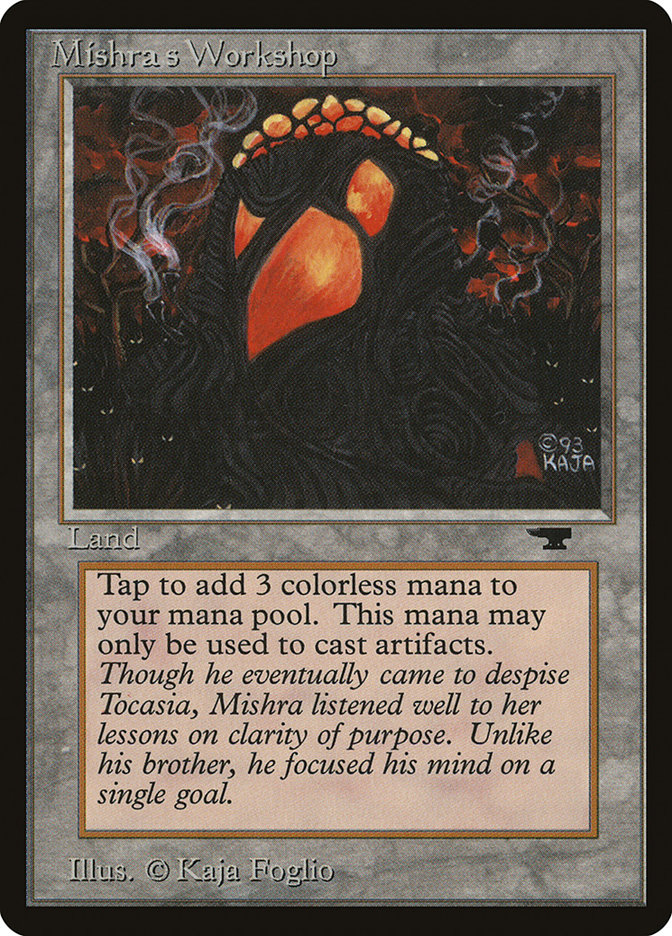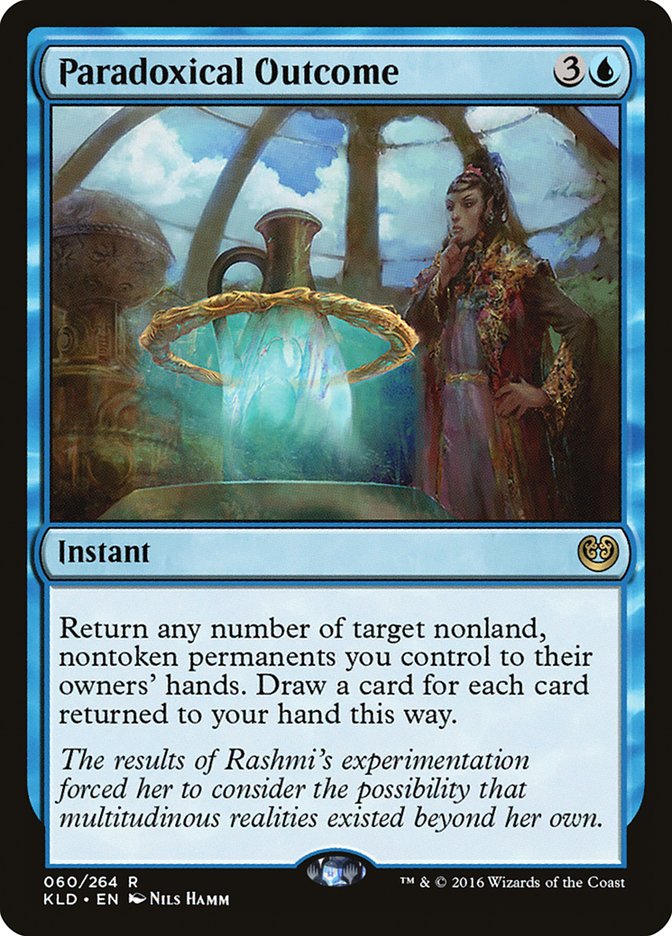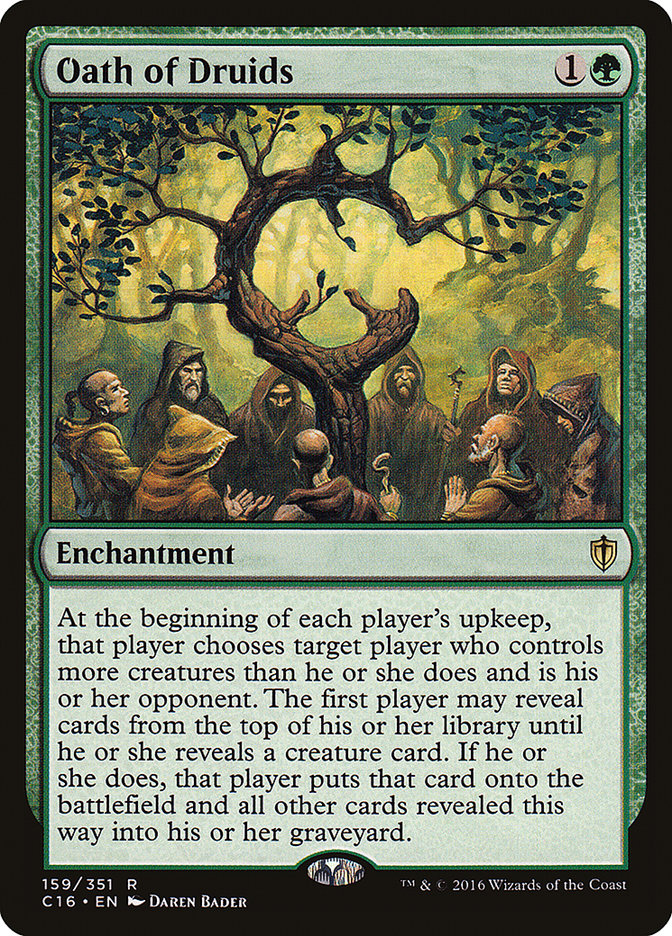In a five year stretch from July 2004 until May 2008, StarCityGames.com
awarded 243 pieces of the Power 9 to top finishers in a series of
tournaments that changed the Vintage format forever. Spanning 27
tournaments held in eight cities in five different states, the
StarCityGames.com Power 9 Series was the largest ever independently
organized Vintage tournament series. Averaging more than a hundred players
per tournament (101.779 to be precise!), it was a proving ground for the
format’s most dedicated players and the spawning ground for some of the
most creative and brilliant deck concepts in the format’s 25-year history.
For the first time in a decade,
the Power 9 Series is returning to SCGCON on Friday, June 8
. To commemorate the occasion – and to help you prepare for this fantastic
opportunity – I am honored to kick off a week of Vintage content by
revisiting some of the highlights of this remarkable series and discussing
the anticipated metagame. If you’re a Vintage enthusiast, this is a
tournament you will not want to miss.
As your guide to this special event and the stroll down memory lane, allow
me to introduce myself. My name is Stephen Menendian, and I’m the
2007 Vintage World Champion
as well as the
Season 1 Vintage Super League champion
. From
2002
until
2010
, I wrote more than three hundred articles for this website, mostly Vintage
strategy. Most importantly, I hold the record for number of Top 8
appearances in the SCG Power 9 series, with
seven Top 8 finishes (and a pair of ninth place heartbreakers)
.
Andy Probasco, whom you will also hear from, likely holds the “road
warrior” record for most tournaments in the series attended, and enjoys a
four-way tie for second most Top 8 appearances.
Origins
At the dawn of the millennium, the Type 1 format (as Vintage was then
known) was largely a defunct format. There were virtually no organized
events, let alone sanctioned tournaments, for Type I competition. The
emergence of internet forums like
Beyond Dominia
drew Type I enthusiasts together and helped kindle a shared passion for the
format. Bdominia moderators
Oscar Tan
(aka Rakso) and
Darren Di Battista
(aka Azhrei) found an even larger audience on the fledging
StarCityGames.com website.
As a pioneer in the hybrid online store and strategy content website model,
StarCityGames.com quickly onboarded several writers dedicated to niche
formats like Type I, giving the format more visibility than it enjoyed
elsewhere. For five years, Oscar Tan entertained and educated Magic players
about the thrill and deep strategy of Type I and helmed a growing stable of
Type I content providers, including myself and many others.
StarCityGames parlayed readership into actual Type I tournaments. As the
tournament organizer for Virginia States in 2002, StarCityGames.com
experimented with a Type I side event that was a surprising success. The
winner returned the favor by
publishing his tournament report
on the strategy side of the site, in a virtuous circle, furthering
promoting the format and providing content for the website. When Wizards of
the Coast announced the inauguration of an official “Type I Championship”
at Gencon in 2003, garnering nearly 200 players, it was in no small part
due to the contribution of StarCityGames in cultivating a Type I player
base. This, in turn, inspired StarCityGames to attempt a bolder venture.
Tapped to co-organize Grand Prix Washington DC held in April, 2004,
StarCityGames announced a
major Type I side event
that would award a trophy, a pair of Black Lotuses, Mox Emerald, and Juzam
Djinn, among other prizes, to the Top 8 finishers. Dubbed the “East Coast
Vintage Championship,” this side event
drew 90 players
at a time when the GP itself had only 573 players. A roaring success, this
was the precursor to an even bigger and more ambitious effort. Not long
after, StarCityGames announced that it would launch a “Power 9”
tournament for mid-July in Richmond, Virginia. The tournament name
reflected a very special prize purse: a copy of a Power 9 card to every
Top 8 finisher. 167 players registered for this very special event and the
Power 9 Series was born.
The Power 9 Series Sets Sail
With a total of three Vintage Power 9 tournaments held in 2004 (two in
Richmond and the third in Chicago), the series scaled up in a major way in
2005 with nine events rotating from Richmond to Chicago to upstate New York
(originally Syracuse, then Rochester). Then, in 2006, SCG held ten Power
Nine tournaments, sweetening the draw by making each stop a double-header,
with a Saturday and Sunday tournament. The series also expanded to new
cities such as Boston, Charlotte, and SCG’s home base Roanoke, Virginia. In
2007, the series scaled back but drew strong attendance overall, with
one-day events held in Roanoke, Indianapolis, and Chicago. Then, in 2008,
the series concluded with a two-day event in Richmond.
The Power 9 tournament series not only helped bring Vintage into new
regions and experimented with different tournament structures; it also
regularly tweaked the rules and prize support. Originally launched by
permitting players to proxy five cards, the series eventually allowed
players to proxy up to fifteen cards, to allow players to more readily
afford the format and reduce the barrier to entry. The success of the
series had the unfortunate byproduct of making key Vintage staples
increasingly expensive. By 2006, StarCityGames was awarding Timetwister to
the ninth-place finisher (for which I am doubly thankful!) instead of to
the winner.
Most importantly, StarCityGames deployed serious, high quality professional
coverage teams to most of the tournaments in the first full year of the
series. For example, the coverage of the first event, led by Ted Knutson,
featured more
than twenty individual articles,
including match coverage, player interviews, a metagame breakdown, and
humorous commentaries. The
coverage for the sixth event in the series
, held in Chicago in the spring of 2005, went further than ever imagined,
and included a complete analysis of the entire metagame,
down to every single card in the tournament
(all the way down to Zuran Orb) and
archetype match win percentages
.
With the seventh event, SCG jettisoned the coverage team for something
simpler, and perhaps most valuable: a
complete list of every deck in the tournament
. With one exception, it continued this practice up through the 23rd
tournament, held in Roanoke in June 2007 (the last four tournaments have
Top 8 decks reported only). What that means as a practical matter is that
the vast majority of every deck played in the series is archived in the
StarCityGames.com Deck Database in order of final standings. It’s a
treasure trove of Vintage deck ideas and concepts, both bad and good.
Although well before the era of streaming coverage and smart phones,
players regularly phoned updates to friends who in turn posted
round-by-round notes on message boards and internet forums to satisfy fans
at home who avidly refreshed coverage pages, pining for new tech and nifty
deck ideas. It’s hard to overstate the excitement generated by these
events. Players traveled from far and wide to compete in one of their
favorite formats or eagerly awaited decklists the Monday after, if they
couldn’t make it.
Beyond the thrill of competing in Vintage tournaments for high-value
prizes, there were other incentives and attractions. Wizards R&D staff
member, Aaron Forsythe, made a special trip to the second tournament in the
series (which he was permitted to play in because it was unsanctioned), and
wrote a fascinating report
of his experience. More tantalizingly, R&D head, future Hall of Famer,
and Vintage Super League creator, Randy Buehler, made a special trip to the
first double-header in 2006. To sweeten the pot, in an “open letter to the
Type 1 Community” Randy
“guaranteed” that he’d Top 8 at least one of the events
, and promised twelve packs of Russian 9th Edition to anyone who
beat him (more on that later)!
But the coolest incentive, and the most well-attended event in the series,
was a special
‘shooting stars’ event
held in Rochester in July, 2005. The concept was simple: invite some of the
best Magic players in North America, including several Pro Tour winners, to
compete with the Vintage community. Each of the “shooting stars” were given
special t-shirts which they had to give away if they lost a match.
Here was the list of “stars,” a mix of Vintage experts and professional
players:
- Zvi Mowshowitz
- Chad Ellis
- Rich Hoaen
- Steve Wolfman
- Ken Krouner
- Josh Rider
- Craig Krempels
- Kevin Cron
- Ben Kowal
- Ben Bleiweiss
The event was a huge success, and the most well attended tournament in the
series, with
173 players showing up to compete
.
Deck Highlights
The StarCityGames.com Power 9 Series spanned one of the most energetic
and interesting periods of Vintage history. New deck ideas emerged in rapid
succession, upending metagames and shaking up the format. Players embargoed
their best deck ideas, holding them in reserve for this tournament series
to surprise or stun competitors. New printings and changes to the Banned
and Restricted List created opportunities for innovation and creative deck
concepts at every turn.
One of the earliest examples of the potential for new sets to change the
metagame was vividly illustrated early in the series. Champions of Kamigawa was released in the Fall of 2004, just weeks
before the second Power 9 tournament in Richmond. This set held enormous
Vintage potential, with cards like Gifts Ungiven and Sensei’s Divining Top.
My team, however, quickly identified Forbidden Orchard as the most
important new printing in the set, given the potential Oath of Druids had
in a metagame defined, primarily, by Keeper (3-4 Color Control), Workshop
Aggro, and Control Slaver (which had just won the 2004 Vintage
Championship). I spent several weeks intensely testing and tuning the best
possible Oath of Druids deck and stunned the tournament by putting most of
our team in the Top 8 with “Meandeck Oath,” which made up 50% of the Top 8
(with some teammates losing mirror matches in the final round) and winning
the event. Here was the deck I designed:
Creatures (2)
Lands (12)
Spells (46)

Shortly thereafter, I published a
deck primer and tournament report
. There were very few other players in the tournament attempting Forbidden
Orchard Oath, with Aaron Forsythe being a notable exception (playing a
combo list with Eternal Witness). My deck was designed to win as quickly as
possible after triggering Oath of Druids, and therefore eschewed
Blightsteel Colossus in favor of hasty creatures which could combine for
eighteen damage in just two attack steps. We surrounded these creatures
with a dense suite of countermagic and draw spells to out-control control
decks. Although the sideboard plan included alternative Oath targets for
specialized situations, we calculated that players would be unprepared for
this surprise strategy, and therefore designed built-in weaknesses that we
knew players would not be able to exploit, such as to Platinum Angel. At
the very next SCG Power 9 tournament, Platinum Angel was out in force.
Around the same time, the
DCI cleaned up the Vintage Banned and Restricted List
and unrestricted Doomsday, among other cards. After a teammate surfaced a
particularly intriguing package of cards to abuse with Doomsday, I settled
on Doomsday for the third event in the series in Chicago, and spent my
time, once again, tuning the best possible list. I was rewarded with a
third-place finish for my efforts, with this list:
Lands (11)
Spells (49)
- 1 Tendrils of Agony
- 4 Brainstorm
- 2 Cabal Ritual
- 1 Vampiric Tutor
- 1 Mystical Tutor
- 1 Yawgmoth's Will
- 4 Duress
- 4 Force of Will
- 1 Necropotence
- 1 Demonic Tutor
- 1 Hurkyl's Recall
- 3 Island
- 4 Doomsday
- 1 Time Walk
- 4 Dark Ritual
- 1 Ancestral Recall
- 4 Unmask
- 1 Gush
- 1 Timetwister
- 1 Mind's Desire
- 1 Beacon of Destruction
- 1 Lim-Dul's Vault
- 1 Chromatic Sphere
- 1 Black Lotus
- 1 Lotus Petal
- 1 Lion's Eye Diamond
- 1 Mox Jet
- 1 Mox Sapphire
Sideboard

The combo kill was simple, but flashy: cast Doomsday, and then stack
Ancestral Recall on the top of your library to draw Black Lotus, Dark
Ritual, and Mind’s Desire. This would allow you to play Mind’s Desire with
three additional storm copies to flip the final card in your library,
Beacon of Destruction, exactly four times to win the game. My
tournament report
illustrated the power of this combo as well as its surprise value.
Doomsday, indeed!
Sometimes, performances on the Power 9 Series preceded and precipitated
restrictions. Eric Miller Top 8ed three of the first four events with
Trinisphere-powered Workshop Aggro decks using Juggernaut and Crucible of
Worlds-fueled Wasteland recursion to keep opponents from breaking out of
the Trinisphere lock. Control Slaver decks, however, had gradually found a
way to overcome the Workshop prison, using basic lands and Darksteel
Citadel to anchor their manabase, and Goblin Welder to manipulate the
Workshop player’s battlefield. Rack and Ruin and Thirst for Knowledge were
two critical tactics unimpeded by Trinisphere.
Reflecting a metagame adjustment, Kevin Cron brought a very unusual Stax
deck to SCG Power 9 5 in Syracuse in March, 2005, winning the event with
this deck:
Creatures (4)
Lands (18)
Spells (38)
- 1 Vampiric Tutor
- 1 Yawgmoth's Will
- 2 Swords to Plowshares
- 1 Mana Vault
- 1 Balance
- 1 Sol Ring
- 1 Mind Twist
- 1 Demonic Tutor
- 1 Ancestral Recall
- 1 Mana Crypt
- 3 Chains of Mephistopheles
- 4 Sphere of Resistance
- 3 Crucible of Worlds
- 3 Trinisphere
- 4 Smokestack
- 1 Demonic Consultation
- 1 Tinker
- 1 Crop Rotation
- 1 Black Lotus
- 1 Lotus Petal
- 1 Mox Emerald
- 1 Mox Jet
- 1 Mox Pearl
- 1 Mox Ruby
- 1 Mox Sapphire
Sideboard

Emphasizing Sphere of Resistance over Trinisphere based upon a recognition
that Sphere was more impactful against three casting-cost spells, Kevin
supplemented his prison elements with enchantments like Chains of
Mephistopheles to disrupt the Brainstorm/Thirst draw engines. Gorilla
Shaman also interfered with the Control Slaver player’s mana base and
allowed him to neutralize Goblin Welders. Just days later, Trinisphere was
restricted.
The restriction of Trinisphere opened new metagame possibilities, and one
of them was the dormant but incredibly powerful blue engine, Gifts Ungiven.
A card that would long reign over the format, Ben Kowal and Andy Probasco
designed a tournament winning Gifts strategy, which was unleashed at the
sixth SCG Power 9 tournament held in Chicago in the spring of 2005:
Creatures (3)
Lands (14)
Spells (43)
- 4 Brainstorm
- 4 Mana Drain
- 1 Mystical Tutor
- 1 Yawgmoth's Will
- 2 Duress
- 4 Force of Will
- 1 Mana Vault
- 1 Sol Ring
- 1 Demonic Tutor
- 1 Island
- 1 Time Walk
- 1 Ancestral Recall
- 1 Mana Crypt
- 1 Mana Severance
- 2 Gifts Ungiven
- 4 Thirst for Knowledge
- 1 Mindslaver
- 1 Goblin Charbelcher
- 1 Chain of Vapor
- 1 Tinker
- 1 Black Lotus
- 1 Fact or Fiction
- 1 Recoup
- 1 Lotus Petal
- 1 Mox Emerald
- 1 Mox Jet
- 1 Mox Pearl
- 1 Mox Ruby
- 1 Mox Sapphire

Gifts Ungiven was used to find Tinker, Mana Severance, Recoup, and
Yawgmoth’s Will. Provided you had enough mana, you could easily win no
matter what your opponent selected for you.
The restriction of Trinisphere opened creative possibilities for Workshop
players as well. A newcomer, Robert Vroman, top 8ed the same tournament
with a very unusual Workshop strategy he dubbed “Uba Stax.” Remarkably,
Vroman would go on to win the second and third tournaments held in Chicago
that year with the exact same strategy:
Creatures (12)
Lands (15)
Spells (33)
- 1 Mana Vault
- 1 Wheel of Fortune
- 1 Sol Ring
- 5 Mountain
- 1 Mana Crypt
- 3 Null Rod
- 3 Uba Mask
- 3 Crucible of Worlds
- 1 Trinisphere
- 4 Smokestack
- 1 Black Lotus
- 1 Mox Emerald
- 1 Mox Jet
- 1 Mox Pearl
- 1 Mox Ruby
- 1 Mox Sapphire
- 4 Chalice of the Void
Sideboard

Vroman’s deck abused powerful, but unexpected synergies. Uba Mask was a
seemingly innocuous threat which powerfully impeded blue deck’s
accumulation of card advantage. At the same time, Bazaar of Baghdad allowed
the Stax player to effectively negate Bazaar’s drawback, giving immediate
access to the drawn cards regardless of hand size. In addition, Bazaar and
Goblin Welder were a powerful combo, and allowed the Stax player to turn a
Mox into the most powerful artifact in the graveyard. Some wondered at the
time if this was the most powerful Vintage deck in the metagame.
Despite the rise of Gifts, the best performing blue deck of 2005 was
probably Control Slaver. Just as Vroman Top 8ed all three of the Chicago
Power 9 Series stops in 2005, winning two of them, Canadian Ugo Rivard
duplicated the feat, with a near mirror image, in Rochester the same year:
top 8ing all three stops in upstate New York, winning the first two,
including the “Shooting Stars” tournament, with Canadian Control Slaver:
Creatures (5)
Lands (14)
Spells (41)
- 4 Brainstorm
- 4 Mana Drain
- 1 Vampiric Tutor
- 1 Mystical Tutor
- 1 Yawgmoth's Will
- 4 Force of Will
- 1 Sol Ring
- 1 Demonic Tutor
- 3 Island
- 1 Time Walk
- 1 Ancestral Recall
- 1 Mana Crypt
- 3 Mana Leak
- 1 Crucible of Worlds
- 4 Thirst for Knowledge
- 1 Mindslaver
- 1 Echoing Truth
- 1 Tinker
- 1 Black Lotus
- 1 Fact or Fiction
- 1 Mox Emerald
- 1 Mox Jet
- 1 Mox Pearl
- 1 Mox Ruby
- 1 Mox Sapphire
Sideboard

This simple but powerful strategy used the most broken cards in the Vintage
format in a control shell while ultimately achieving a “lock” with
Mindslaver and Goblin Welder to grind the opponent out of the game. Control
Slaver’s reign extended into 2006. Control Slaver then won both days of the
first-double header in the Power 9 Series in 2006 in the hands of Rich
Shay and Brian Fisher, respectively. Although Rich did not win the second
day’s tournament (after
I gave him a second loss with a pair of turn 1 kills
in the fourth round), he did manage to defeat Randy Buehler in the very
first round in the most hilarious manner: Randy attempted to execute a turn
one victory with Grim Long, forgetting that Rich had played a first turn
Tormod’s Crypt. When Randy attempted to combo out with Yawgmoth’s Will,
Rich thwarted him by Crypting his graveyard
and knocking him out of the game.
Dispelling myths about the format, three different players Top 8ed both
tournaments that weekend, but I was the only player to do it with two
different decks. I top 8ed day 2, as hinted above, with a Dark Ritual combo
deck known as “Grim Long” for its use of Grim Tutor, but I Top 8ed the day
before with a completely novel strategy that was best known at the time as
“Friggorid,” but which is recognized today as Dredge:
Creatures (20)
Lands (14)
Spells (26)
- 4 Brainstorm
- 1 Vampiric Tutor
- 1 Time Walk
- 1 Ancestral Recall
- 1 Imperial Seal
- 2 Careful Study
- 4 Cabal Therapy
- 1 Crop Rotation
- 1 Black Lotus
- 1 Lotus Petal
- 1 Mox Jet
- 1 Mox Sapphire
- 4 Chalice of the Void
- 1 Chrome Mox
- 2 Darkblast
Sideboard

Although Ravnica had introduced the dredge mechanic just months
before, it took some time for players to fully appreciate how broken the
mechanic truly was. After
months of tuning
, I earned the position of being the first player to Top 8 a Vintage
tournament, let alone a large one, with a Dredge deck, illustrating, once
again, how the Power 9 Series was a platform for innovation. Although
rudimentary by contemporary standards, many of the powerful cards
associated with Dredge had not seen print, from Bridge from Below to
Narcomoeba, since they were printed in Future Sight, which was
more than a year away. This was nonetheless the very first strategy in
Magic that could consistently win without casting a single spell. It
exploded basic notions of what was possible in Vintage and Magic more
generally.
Fast forward more than a year to the summer of 2007: the DCI shook up the
Vintage format by simultaneously restricting Gifts Ungiven in a hostage
trade with Gush, which was now permitted as a four-of. The Dark Ritual
combo and Gifts Control metagame instantly vanished, replaced by a Workshop
and Gush heavy metagame. After I won the Vintage Championship that August
with GroAtog, a Gush strategy, the StarCityGames.com Power 9 series’
24th tournament, held in Indianapolis, a month later, had an unforgettable
Top 8:
seven Gush decks and one Dredge deck
, with Owen Turtenwald, then a Vintage enthusiast, winning the tournament
with this deck:
Creatures (2)
Lands (13)
Spells (44)
- 4 Brainstorm
- 1 Fastbond
- 2 Mana Drain
- 1 Vampiric Tutor
- 1 Mystical Tutor
- 1 Yawgmoth's Will
- 4 Duress
- 4 Force of Will
- 1 Sol Ring
- 1 Regrowth
- 1 Demonic Tutor
- 1 Island
- 1 Time Walk
- 1 Ancestral Recall
- 1 Red Elemental Blast
- 4 Gush
- 1 Gifts Ungiven
- 4 Merchant Scroll
- 1 Echoing Truth
- 1 Pyroblast
- 1 Misdirection
- 1 Tinker
- 1 Black Lotus
- 1 Mox Emerald
- 1 Mox Jet
- 1 Mox Ruby
- 1 Mox Sapphire
- 1 Empty the Warrens

The top 8 bedeviled commentators who simultaneously embraced and feared the
shock value of several different Gush decks in a single Top 8. While Gush
would prove pre-eminent, it would recede a bit in the following months.
The SCG P9 series closed out 2007 in Chicago, where Owen and his teammates
brought a hilarious strategy based on a new erratum which allowed Phyrexian
Dreadnaught’s ‘enters the battlefield’ trigger to be Stifled. Dubbed “Deez’
Naughts,” this deck was an Aggro Control strategy with a powerful finisher:
Creatures (12)
Lands (17)
Spells (31)

This deck epitomized the synergies available to innovative deck designers
exploiting new errata, not just new printings or changes to the banned and
restricted list.
After the release of Future Sight in early May, 2007, Protean
Hulk-Flash combo became one of the most powerful decks ever created in
Vintage, easily winning the game with just two mana to cast Flash. Future
Sight amplified the decks power by giving it cards like Pact of Negation
and Summoner’s Pact. But the card, oddly enough, that put Flash over the
top in Vintage was Morningtide‘s Reveillark in the Spring of 2008,
creating what many called ”
the best deck ever
.” Reveillark enabled a complex finish that included Body Double, Carrion
Feeder, and Body Snatcher, which Patrick Chapin
describes here
. The importance of this kill was that it could occur at instant speed,
including with a Pact trigger on the stack in your own upkeep. This allowed
the Flash player to use Pact of Negation more aggressively, on offense and
defense.
It was in this context that the final event in the Power 9 Series, and a
double-header tournament, was held just a few weeks later in Roanoke. The
first day’s tournament was won by Andy Probasco, employing a very recent
and unusual printing from Shadowmoor to trump the entire field:
Creatures (4)
Lands (13)
Spells (43)
- 4 Brainstorm
- 1 Fastbond
- 3 Mana Drain
- 1 Vampiric Tutor
- 1 Yawgmoth's Will
- 4 Force of Will
- 3 Grindstone
- 1 Sol Ring
- 1 Demonic Tutor
- 2 Island
- 1 Time Walk
- 1 Ancestral Recall
- 2 Red Elemental Blast
- 1 Mana Crypt
- 4 Gush
- 1 Timetwister
- 1 Gifts Ungiven
- 3 Merchant Scroll
- 3 Pyroblast
- 1 Tinker
- 1 Black Lotus
- 1 Mox Jet
- 1 Mox Ruby
- 1 Mox Sapphire
Sideboard

In a field of Flash, Gush, and Tidespout Tyrant Oath, Pyroblast and Red
Elemental Blast were about the best tactics in the format. Painter’s
Servant made this tactic a legitimate maindeck threat, since it would be
used with general purpose aim with Painter’s Servant on the battlefield.
Moreover, Painter’s Servant enabled a new combo with Grindstone for a combo
flourish. Andy Probasco’s innovative Painter combo control deck won the
first tournament of the weekend, and the penultimate tournament in the
Power 9 Series thus far.
Over five years, the SCG Power 9 Series was a showcase for a variety of
innovative and interesting strategies in every major corner of the format.
But what may be most remarkable of all is that, despite 27 tournaments with
216 possible Top 8 slots among them, there were only 138 unique players who
ultimately Top 8ed. 21 players top 8’d exactly twice. Twelve players had
exactly three top 8 appearances. Six players had exactly four Top 8
appearances. And just four players top 8’ed five times:
- Andy Probasco
- Brian DeMars
- Ben Kowal
- Tommy Kolowith
Just one player had more than five Top 8 appearances, myself with seven.
Although no one will be able to break my record at SCG CON upcoming, I will
be present to try to Top 8 once more.
The legacy of the Power 9 Series lays primarily in the role in played in
reviving a moribund format, both promoting the format in a dynamic synergy
with coverage and strategy articles, which in turn helped dispel myths
about the format and attract new player interest.
But the series was a bold
venture for StarCityGames and helped prove that an independent company
could manage and run a complex web of tournaments in different parts of the
country. In mid-2010, SCG launched the Legacy and Standard 5K tournaments,
modeled in large part on the Power 9 Series double-headers, with a
Standard tournament one day and Legacy the other. Before 2012, SCG had
organized
50 such tournaments
, which has now morphed into the SCG Tour.
In that sense, the Power 9 Series helped build the SCG tournament
empire!
The 2018 Vintage Metagame
Fast forward to the summer of 2018 and with Vintage a bit more open than
it’s been in some time, thanks to printings and a succession of
restrictions and unrestrictions (including Yawgmoth’s Bargain!) The format,
however, is controlled by four main archetypes: Jeskai Mentor, Paradoxical
Control, Oath of Druids Control, and Workshop Aggro. I expect that these
four decks will together make up more than 50% of the metagame at the Power
Nine tournament at SCG CON. Dredge is a perennial menace and will be
decently represented as well. And I expect a better-than-usual showing for
Dark Petition Storm combo featuring Yawgmoth’s Bargain, since this is a
deck that is fun to play in paper and it’s well-positioned.
Workshop Aggro not only won the most recent North American Vintage
Championship, but dominated it late last year, putting up five players in
the Top 8, and preventing any Gush/Delve decks from making top 8. Although
it has waned a bit of late (with zero copies in the most recent Eternal
Weekend Europe Vintage Championship), Workshop Aggro is still one of the
top decks to beat. The combination of Arcbound Ravager and Walking Ballista
is a tag team duo that is fast as it is resilient. This deck, however, has
two key weaknesses: Hurkyl’s Recall and Ancient Grudge. Ancient Grudge is
the key disruptive tactic of the Oath of Druids deck, and Hurkyl’s Recall
is now the key disruptive tactic of the Paradoxical strategies. Both seem
well-positioned to attack Workshops, which has gotten a boost with Traxos,
Scourge of Kroog as a new efficient finisher.
Paradoxical Outcome strategies are on the rise in this Vintage metagame,
having just won The Mana Drain Open 19, one of the nation’s largest Vintage
tournaments. However, this strategy is extremely weak to Null Rod and Stony
Silence tactics, making Jeskai Mentor armed with Stony Silence a slightly
unfavorable matchup. The Paradoxical deck, however, is well-positioned to
overpower Oath strategies, to the annoyance of Brian Kelly.
In summary, the Workshop Aggro deck is favored against the so-called
Turbo-Xerox strategy of Jeskai Mentor, but weak to both the Oath and
Paradoxical strategies at the moment. The Paradoxical strategy is strong
against Oath and Workshops, but weak to Jeskai Mentor. The Oath deck is
well-positioned against Jeskai Mentor and Workshops but is weak to
Paradoxical. In short, if you play one of the four main strategies, you
must pick your poison. Or, alternatively, try to tweak one of those
strategies to shore up its weaknesses as best you can. But if you go rogue,
there is no shortage of options for you to explore. Above all, find a deck
that will entertain you and be a fun joy ride, because this will likely be
one of the longest Vintage tournaments ever held, with 13 rounds of swiss
and a cut to Top 8.
Post-Script: for a more comprehensive history of the Power 9 series,
including an appendix containing links to every decklist and coverage page,
check out my article here
.


